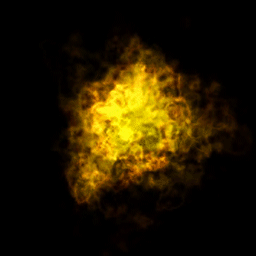The greater draft of a firestorm draws in greater quantities of oxygen, which significantly increases combustion, thereby also substantially increasing the production of heat. The intense heat of a firestorm manifests largely as radiated heat (infrared radiation) which ignites flammable material at a distance ahead of the fire itself. This also serves to expand the area and the intensity of the firestorm. Violent, erratic wind drafts suck movables into the fire, while people and animals caught close or under the fire die for lack of available oxygen. Radiated heat from the fire can melt asphalt, metal, and glass, and turn street tarmac into flammable hot liquid. The very high temperatures replicate the conditions of a smelting furnace,where anything that might possibly burn does so readily, until the firestorm runs out of fuel.
Besides the enormous ash cloud produced by a firestorm, under the right conditions, it can also induce condensation, forming a pyrocumulus cloud or "fire cloud". A large pyrocumulus can grow into a pyrocumulonimbus and produce lightning, which can set off further fires. Apart from forest fires, pyrocumulus clouds can also be produced by volcanic eruptions.
In Australia








